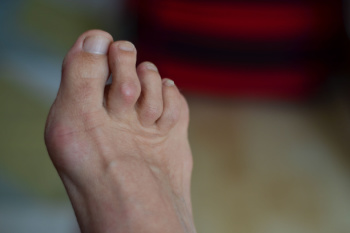
A hammertoe occurs when a toe bends downward at the end and curls at the middle joint, often leading to stiffness and pain. Hammertoe most commonly affects the second toe but can develop in others as well. Early signs of a hammertoe include a bent toe that remains flexible, but, over time, it can become rigid and painful. Friction from footwear may cause corns, calluses, or blisters on the top of the toe or the bottom of the foot, making walking uncomfortable. Hammertoe is often caused by wearing shoes that are too tight or narrow, which forces the toes into an unnatural position. High heels and certain foot structures, such as long toe bones or bunions, can increase the likelihood of developing a hammertoe. A podiatrist can assess the severity of the hammertoe and recommend treatment, which may include changing footwear or using orthotic devices to relieve pressure. In severe cases where the toe is no longer flexible, surgery may be necessary to correct the deformity. If you have developed a hammertoe, it is suggested that you schedule an appointment with a podiatrist for an exam, diagnosis, and treatment options, which may include surgery.
Hammertoes can be a painful condition to live with. For more information, contact one of our podiatrists of Brondon Foot and Ankle. Our doctors will answer any of your foot- and ankle-related questions.
Hammertoe
Hammertoe is a foot deformity that occurs due to an imbalance in the muscles, tendons, or ligaments that normally hold the toe straight. It can be caused by the type of shoes you wear, your foot structure, trauma, and certain disease processes.
Symptoms
- Painful and/or difficult toe movement
- Swelling
- Joint stiffness
- Calluses/Corns
- Physical deformity
Risk Factors
- Age – The risk of hammertoe increases with age
- Sex – Women are more likely to have hammertoe compared to men
- Toe Length – You are more likely to develop hammertoe if your second toe is longer than your big toe
- Certain Diseases – Arthritis and diabetes may make you more likely to develop hammertoe
Treatment
If you have hammertoe, you should change into a more comfortable shoe that provides enough room for your toes. Exercises such as picking up marbles may strengthen and stretch your toe muscles. Nevertheless, it is important to seek assistance from a podiatrist in order to determine the severity of your hammertoe and see which treatment option will work best for you.
If you have any questions, please feel free to contact our office located in Centerville, OH . We offer the newest diagnostic and treatment technologies for all your foot care needs.
